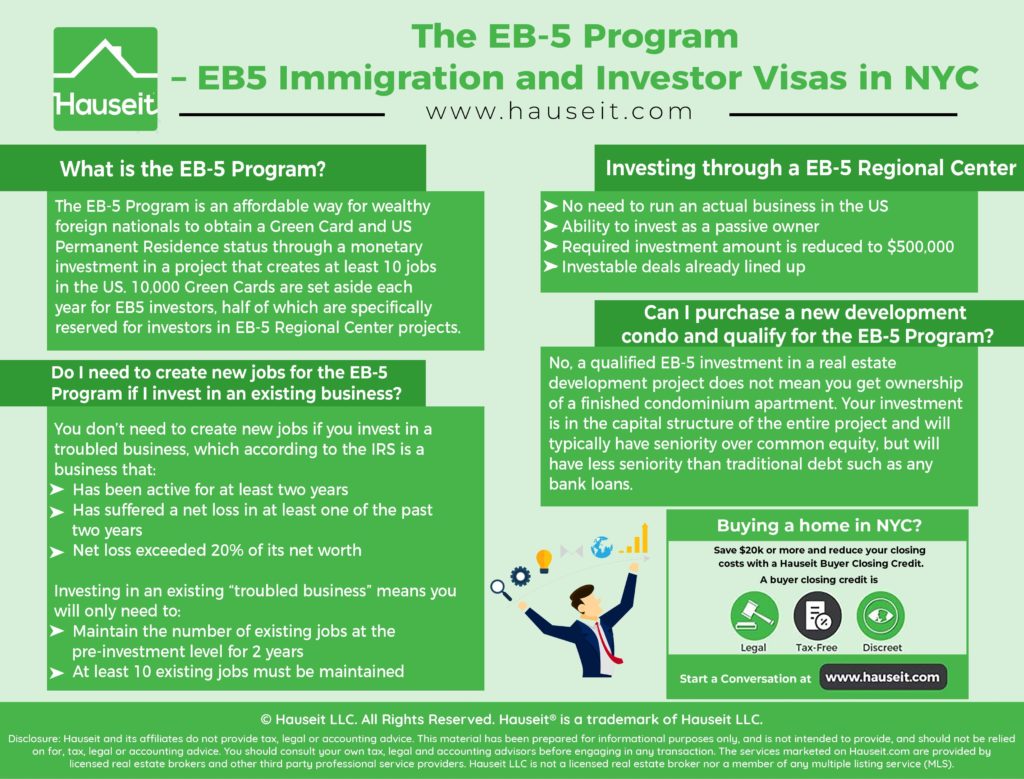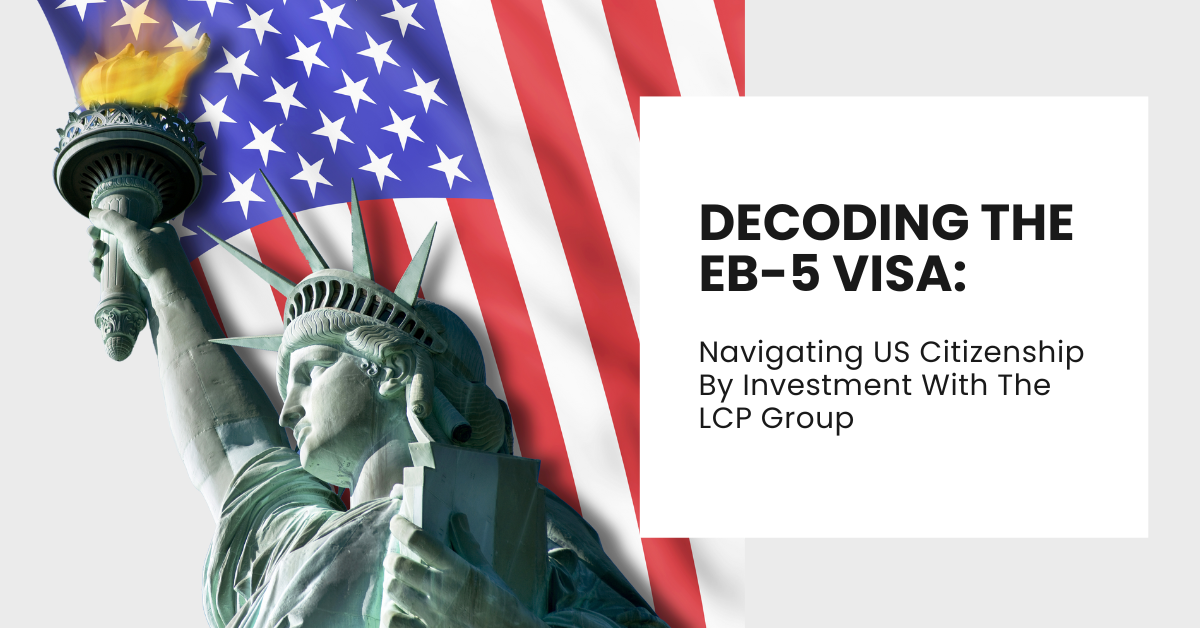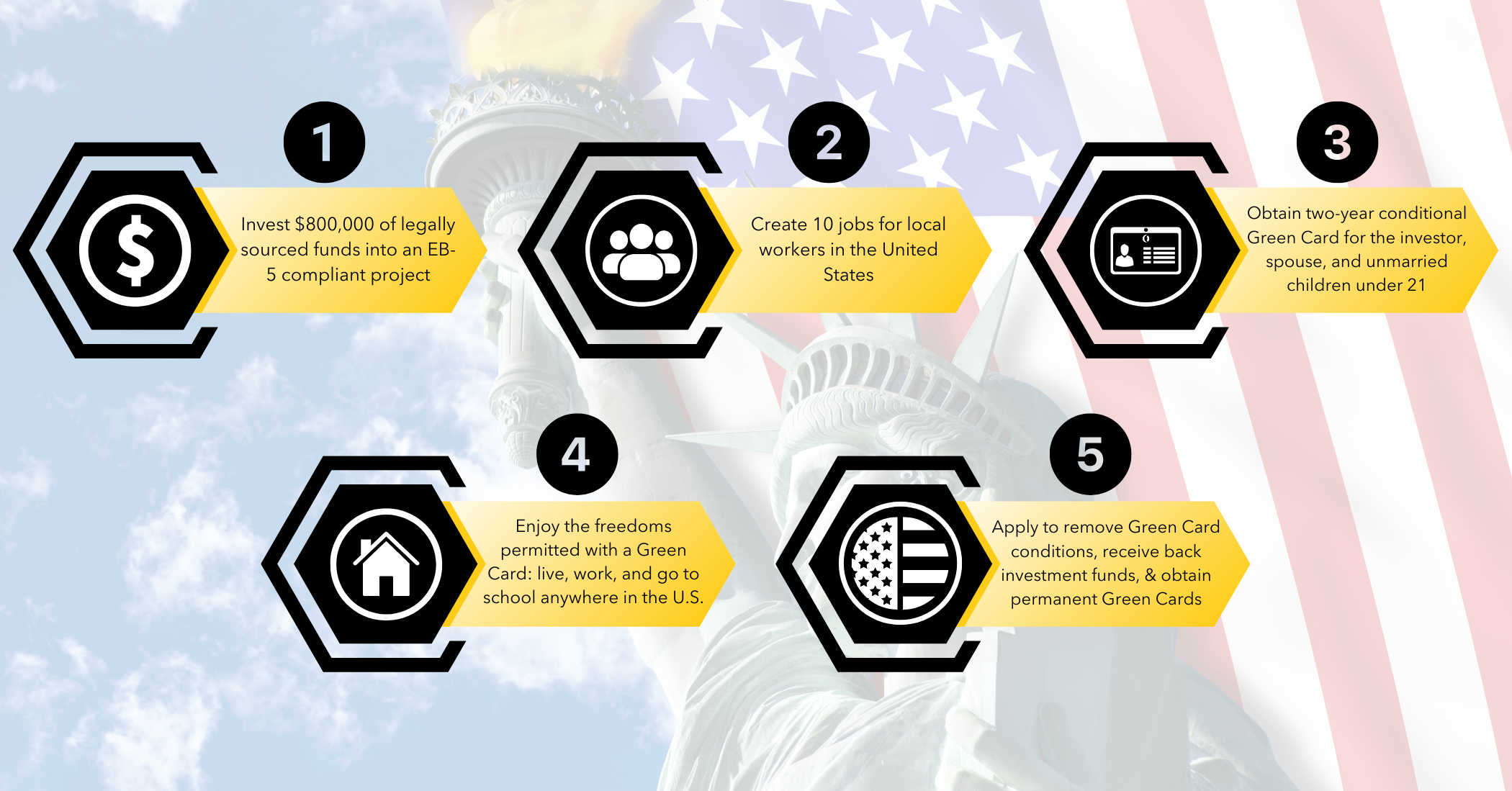EB-5 Visa Explained: Just How to Acquire a Visa Via Investment
The EB-5 Visa program provides a distinct chance for foreign financiers seeking united state permanent residency through a structured investment technique. With details qualification standards and financial investment limits, the procedure needs careful consideration and calculated preparation. Understanding the subtleties of the application procedure, including the distinctions in between straight investments and local centers, is important for possible applicants. As this pathway unravels, potential investors should navigate numerous benefits and difficulties that accompany it. What are the crucial aspects that can affect the success of an EB-5 application?
Introduction of EB-5 Visa
The EB-5 Visa program, designed to boost the U.S. economic situation via international investment, supplies a pathway to irreversible residency for qualified financiers and their family members. Established by the Migration Act of 1990, the program aims to bring in foreign funding to produce work and improve economic development in the USA. Financiers who add a minimum quantity to an accepted job can obtain this visa, thus permitting them to purchase different industries, consisting of actual estate, infrastructure, and other business.
The EB-5 program is particularly appealing because of its twin benefits: a possibility for financial returns on investments and the capacity for united state citizenship. By buying targeted work locations (TEAs), which are specified as rural areas or locations with high unemployment, investors may receive a reduced investment threshold. The program calls for the creation of at the very least 10 full-time tasks for united state workers as a direct result of the financial investment. Effective applicants receive a conditional visa for two years, after which they can use for irreversible residency, given they meet all program needs. This path has actually garnered attention from investors worldwide, making it a necessary part of united state immigration plan.
Qualification Requirements
To get the EB-5 Visa, capitalists must meet specific eligibility standards that assure their financial investment adds to task production and financial growth in the USA - EB-5. Applicants should spend a minimum of $1 million in a new business enterprise, or $500,000 if the financial investment is made in a targeted employment area (TEA), which is usually defined by high unemployment or country places.
Additionally, the venture needs to maintain or create a minimum of 10 full-time work for qualifying united state workers within two years of the capitalist's admission to the United States. Capitalists are likewise called for to demonstrate that their mutual fund were gotten with lawful ways, supplying evidence such as tax obligation returns and financial institution statements.
Another essential criterion is that the financial investment must remain in a for-profit organization entity that was established after November 29, 1990, or one that has actually been restructured or broadened to satisfy the EB-5 requirements. Candidates must show their intent to actively take part in the company, guaranteeing that their participation contributes to its success. Fulfilling these eligibility needs is crucial for investors seeking to obtain long-term residency via the EB-5 program.
Financial investment Options
When taking into consideration the EB-5 visa, financiers have to examine their choices in between straight financial investment chances and regional facility programs. Each selection brings certain task creation demands that are important for satisfying the visa standards. Comprehending these financial investment methods is vital for making a notified decision that straightens with both economic objectives and immigration objectives.
Direct Investment Opportunities
Direct financial investment chances under the EB-5 Visa program offer international financiers with a pathway to acquire united state long-term residency while contributing to the American economy. Unlike regional facility investments, direct investments need financiers to actively handle their organization endeavors within the united state, enabling potential better control and influence over their investment results.
To qualify for the EB-5 Visa with direct financial investment, international nationals need to invest a minimum of $1 million in a brand-new company or $500,000 in a targeted employment location, which is specified as a backwoods or an area with high joblessness. The investment needs to result in the production of at the very least 10 permanent work for certifying U.S. workers within two years.
Straight financial investment choices can differ widely, including industries such as genuine estate advancement, modern technology, hospitality, and production start-ups. Capitalists should perform comprehensive due diligence to examine the feasibility of their selected service model and guarantee compliance with EB-5 policies. Engaging with financial and lawful specialists experienced in EB-5 matters is recommended to navigate the intricacies of direct investment chances and optimize the possibility for a successful application.
Regional Facility Programs
Leveraging the EB-5 Visa program, regional center programs provide a structured financial investment avenue for foreign nationals seeking U.S. long-term residency. These programs are assigned by the U.S. Citizenship and Migration Services (USCIS) and concentrate on merging financial investments to fund various economic growth jobs, which may consist of genuine estate, facilities, and service ventures.
Financiers commonly add a minimum of $900,000 in targeted work areas or $1.8 million in various other regions. EB-5 Investment Amount. One of the main advantages of local center programs is that they enable investors to meet the EB-5 financial investment requirements through indirect job production, instead of guide task creation needed in straight investment possibilities
Regional focuses manage the investment in behalf of the financiers, using a much more easy approach than direct financial investment. This administration consists of managing job development, financial coverage, and compliance with USCIS guidelines. Additionally, local centers commonly have actually developed record, improving the self-confidence of prospective financiers.
Eventually, regional facility programs provide a compelling option for those looking to navigate the complexities of the EB-5 Visa procedure while adding to U.S. economic development and job production.
Task Creation Demands
To receive an EB-5 Visa, capitalists should verify that their capital expense results in the creation of at the very least 10 full time work for U.S. employees within two years. This job production demand is a vital component of the EB-5 program, created to stimulate the U.S. economic situation and promote economic development.
Investors can select in between two main financial investment alternatives: straight financial investments and investments through Regional Centers. With direct investments, the capitalist should proactively manage business and guarantee job creation, while additionally showing that the work developed are for U.S. citizens or lawful irreversible citizens. Alternatively, Regional Center financial investments allow financiers to merge their resources right into an assigned job, frequently resulting in indirect job production, which can be counted in the direction of meeting the task demand.
To efficiently meet the work development requirements, it is necessary for capitalists to function carefully with skilled professionals that can lead them through the complexities of the EB-5 program. Correct planning and adherence to laws are essential to confirm compliance and safeguard a course to long-term residency. Failure to satisfy these work development requirements can jeopardize the investor's EB-5 application and their immigration standing.
The Application Process
The application procedure for the EB-5 visa involves a collection of vital actions and certain qualification needs that applicants should meet. Recognizing these requirements is crucial for a successful application. This section will lay out the necessary credentials and give a detailed guide to steering via the procedure.

Qualification Demands Overview
Recognizing the eligibility requirements for the EB-5 visa is important for potential investors seeking to get irreversible residency in the USA. To qualify, a private must demonstrate a minimum financial investment of $1 million in a new company, or $500,000 if the financial investment is made in a Targeted Work Area (TEA), which is specified as a country area or one with high joblessness.
The investor should show that the financial investment will certainly preserve or create at least ten full-time jobs for United state employees within 2 years of the financial investment. The enterprise must also be a for-profit entity and has to be recently established or significantly renovated if it is an existing business.
The applicant should verify that the mutual fund are gotten with legal means, including individual savings, gifts, or fundings sustained by correct paperwork. Additionally, the financier has to actively join business, guaranteeing their engagement in the monitoring of the venture. Meeting these eligibility requirements is crucial for a successful EB-5 application and ultimately protecting an environment-friendly card through this financial investment avenue.
Step-by-Step Procedure
When qualification requirements are met, potential financiers can begin the application process for the EB-5 visa. The initial step entails finishing Kind I-526, the Immigrant Petition by Alien Financier. This kind needs to be come with by supporting paperwork that demonstrates the capitalist's qualifying financial investment and the development of at least ten full-time jobs for U.S. employees.
Upon authorization of Type I-526 by the United States Citizenship and Migration Solutions (USCIS), financiers can get the EB-5 visa with either consular processing or change of status, depending upon their current residency. For those outside the united state, this implies submitting a visa at a united state consulate. Conversely, if currently in the united state, candidates should submit Type I-485, Application to Register Permanent Home or Readjust Condition.
After approval, financiers and their qualified family participants obtain conditional irreversible residency for two years. Within 90 days prior to the expiration of this conditional status, financiers should file Form I-829, Application by Entrepreneur to Remove Problems, to get permanent residency. Successful conclusion of this step finalizes the EB-5 investment process, approving the financier a Visa.
Regional Centers vs. Direct Investments
Navigating the EB-5 visa program entails an essential choice in between local facilities and direct financial investments, each offering distinct pathways to acquiring permanent residency in the USA - EB-5 Visa by Investment. Regional facilities are marked by the USA Citizenship and Migration Solutions (USCIS) to promote financial development through job development. When spending with a local center, capitalists generally contribute to a pooled fund, which is managed by the. This option frequently permits an extra easy investment technique, as the center manages the project and job creation requirements
In contrast, straight financial investments call for financiers to actively handle their very own company ventures in the USA. This method necessitates an extra hands-on involvement, as the capitalist needs to develop and maintain at the very least 10 full time work straight associated to their service. While direct investments might supply higher control over the financial investment end result, they also involve higher obligations and threats.
Eventually, the selection in between direct investments and local centers rests on private risk resistance, wanted involvement level, and financial investment goals. Recognizing these differences is vital for capitalists looking for to navigate the complexities of the EB-5 visa program successfully.
Advantages of the EB-5 Visa
The EB-5 visa program provides various advantages for international investors seeking permanent residency in the USA. Among the most substantial benefits is the opportunity for investors and their immediate member of the family, including spouses and kids under 21, to get a permit, providing them the right to work and live in the U.S. forever.
The EB-5 program does not call for a sponsor, enabling capitalists better autonomy in their migration trip. This program likewise gives a pathway to citizenship after five years of long-term residency, facilitating lasting stability for families. In addition, investing with assigned Regional Centers can be much less difficult, as these entities frequently manage the job and work production needs in behalf of the capitalist.
Moreover, the EB-5 visa can cause substantial economic returns, as investments are usually directed toward companies that can pay. Lastly, by adding to financial development and job creation in the U.S., EB-5 investors play a necessary function in boosting local areas. On the whole, the EB-5 visa functions as an engaging option for those wanting to safeguard a future in the USA while making a positive influence.
Common Obstacles and Considerations
While the EB-5 visa program offers eye-catching advantages for international capitalists, it likewise features its share of challenges and factors to consider that potential candidates should carefully evaluate. One considerable difficulty is the financial commitment included, as the minimal financial investment quantity is considerable, normally evaluated $1 million or $500,000 in targeted employment areas. Investors need to assure that they have adequate resources and a clear understanding of the linked dangers.

Prospective financiers need to conduct extensive due persistance on the financial investment jobs to avoid illegal plans. The success of an EB-5 application hinges on the development of at least 10 full-time jobs for united state employees, necessitating cautious preparation and tracking of the company's performance (EB-5 Investment Amount). Inevitably, steering these difficulties needs a strategic approach and frequently the assistance of skilled professionals in immigration and financial investment law
Frequently Asked Inquiries
The length of time Does the EB-5 Visa Process Typically Take?

Can Family Members Apply With the Main EB-5 Applicant?
Yes, member of the family can apply together with the key candidate. EB-5 Visa by Investment. Qualified dependents typically consist of spouses and single youngsters under 21, permitting them to obtain permits contingent upon the primary applicant's successful visa authorization
What Takes place if My Investment Falls short?
If your investment falls short, it may threaten your immigration standing and the potential for acquiring a permit. It's vital to conduct detailed due persistance and think about threat reduction strategies prior to waging any kind of investment.
Exist Age Restrictions for EB-5 Investors?
There are no certain age limitations for EB-5 investors; nonetheless, the private have to go to least 18 years old to legitimately become part of investment contracts. Minors might qualify through parental investment and sponsorship.
Can I Travel Outside the United State During the Application Process?
Taking a trip outside the U.S. during the application process might influence your condition. It is suggested to seek advice from a migration attorney to comprehend prospective dangers and assurance compliance with all requirements while your application is pending.
Regional centers manage the financial investment on behalf of the investors, offering an extra passive strategy than straight investment. To certify for an EB-5 Visa, investors should verify that their capital investment results in the creation of at least ten full-time work for United state employees within two years. Capitalists can select between two main investment options: straight financial investments and investments with Regional Centers. The capitalist needs to show that the financial investment will certainly protect or produce at the very least 10 permanent tasks for United state employees within two years of the financial investment. Ultimately, the choice between straight investments and regional centers hinges on specific risk resistance, wanted participation level, and investment objectives.